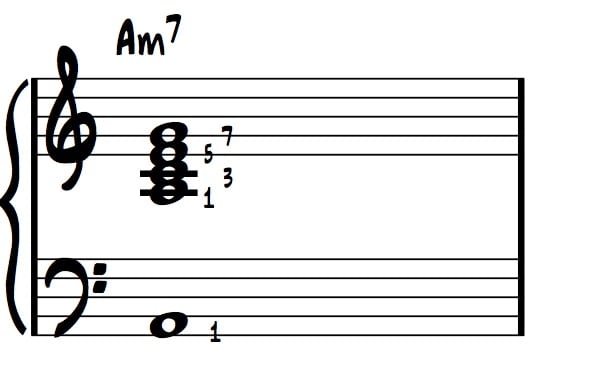In this lesson we will discover 4 voicings to spice up your regular minor chord.
The Minor Chord
The minor chord is based on the degrees 1, 3 and 5 of a minor scale. For this exercise, we will use the A minor chord. The notes of this chord are A, C and E. It is also important to know the inversions of your chord. In this case, the order of the notes of the root position is A, C and E, the order of the notes of the first inversion is C, E and A and finally, the order of the notes of the second inversion is E, A and C.

If the concept of minor chords is new to you, make sure to watch the tutorial explaining how to create major and minor chords on the Online Rock Lessons YouTube channel.
Alternative #1: Minor 7
The first voicing we are learning is the minor 7 chord. This voicing is composed of the degrees I, III, V and VII of the minor scale. In other words, you simply need to add the seventh note of the minor scale to your regular minor chord. The A minor 7 chord is composed of A, C, E and G. Make sure to practice the minor 7 chord in all its inversions.

Russell Ferrante’s Triad on Triad Approach:
Russell Ferrante, pianist and keyboardist, found a different way to explain complex chords. His concept consists of playing a triad over a different triad. For the A minor 7 chord, the A minor chord is played with the left hand and the C major chord is played with the right hand. The A minor and C major chords have two notes in common, C and E, and the G in the C major chord is what creates the sound of the minor 7. You can play with different inversions as well as choose if you want to duplicate certain notes (ex. the C note is found in the A minor chord and the C major chord) or play every note once.

Alternative #2: Minor 9
The second alternative to the regular minor chord we are learning is the A minor 9. This chord is composed of the degrees 1, 3, 5, 7 and 9. The notes of the A minor 9 chord are A, C, E, G and B. Even though the seventh is not mentioned in the name of the chord, it is still implied.
Since this chord is made up of 5 notes, we have to use both of our hands to properly voice it. There are different ways to voice this chord, you can play the degrees 1 and 5 with the left hand and the degrees 7, 9, 3 and 5 with your right hand. The order of the notes of the A minor 9 chord in this voicing is A, E (left hand), G, B C and E (right hand).

Triad on Triad Concept
The equivalent of playing a minor 9 chord is to play a C major 7 chord over an A minor chord. The left hand plays an A (the first degree of the A minor scale) and the right hand plays the C major 7 chord which is composed of the notes C, E, G and B (the degrees 3, 5, 7 and 9 of the A minor scale).
Alternative #3: Minor 11
The third alternative to a regular minor 7 chord is the minor 11 chord which consist of the degrees 1, 3, 5, 7, 9 and 11. The seventh and ninth degrees are not mentioned in the name of this chord but are implied. The notes of the A minor 11 chord are A, C, E, G, B and D.
Since this chord is made up of 6 notes, we have to use both of our hands to properly voice it. There are different ways to voice this chord, you can play the degrees 1 and 5 with your left hand and the degrees 3, 11, 7 and 9 with your right hand. The order of the notes of the A minor 11 chord are A, E (left hand), C, D, G and B (right hand).

Triad on Triad Concept
The minor 11 chord is the equivalent of playing a G major chord over an A minor chord. The left hand plays A, C, E (the degrees 1, 3 and 5 of the A minor scale) and the right hand plays G, B and D (the degrees 7, 9 and 11 of the A minor scale).
Alternative #4: Minor 9(11)
The fourth alternative to the regular minor chord is the minor 11. For this alternative we will play an open voicing.

What Are Open Voicings?
An open voicing is a voicing that has no clusters. It means that there are no notes that are very close to one another. For example, if you want to play C, D and G, the C and D are too close, so you have to change the order of the notes to C, G and D. The D will be an octave higher.
There are different ways to voice this chord. To play an open voicing, you can play the degrees 1 and 5 with your left hand and the degrees 3, 7 and 11 with your right hand. The order of the notes of the A minor 11 in this open voicing are A, E (left hand), C, G and D (right hand).
You now know 4 alternatives to playing a regular minor chord. You can practice these in all keys, chromatically, in all inversions and even play around with a melody with your right hand!
Text Transcription by Andreane Boucher

Founder of Online Rock Lessons, Marine is the keyboardist for Uncle Kracker, Corey Hart and Highway Hunters.
With over 20 years of experience in show business, Marine is launching the first Canadian Music School dedicated to rock and blues lovers.






Questions